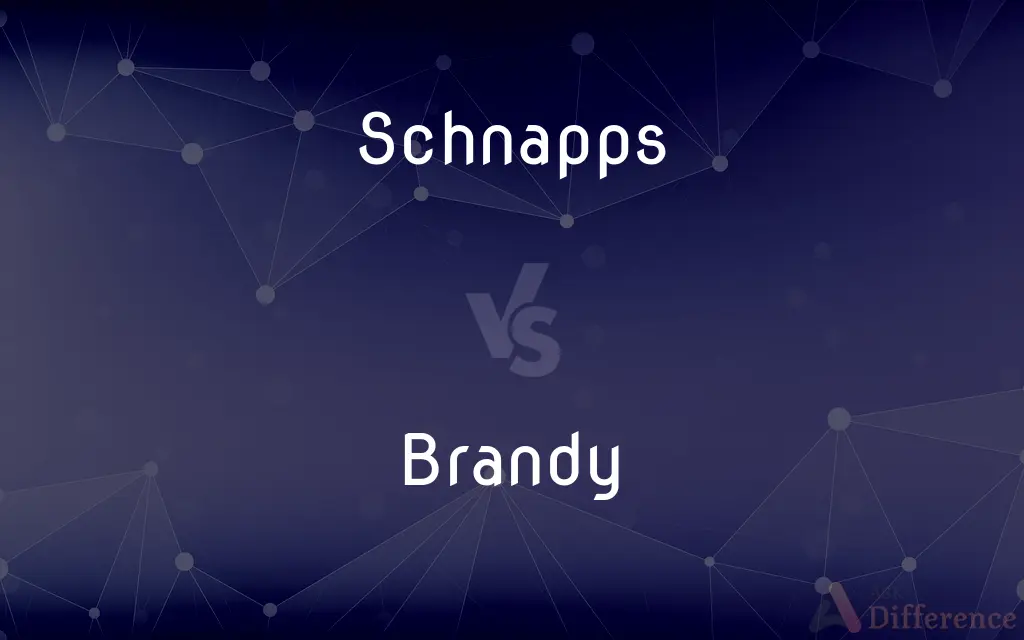Schnapps vs. Brandy — What's the Difference?
By Maham Liaqat & Fiza Rafique — Updated on June 25, 2024
Schnapps is a broad category of distilled spirits, often fruit-flavored, while brandy is distilled from wine or fermented fruit juice.

Difference Between Schnapps and Brandy
Table of Contents
ADVERTISEMENT
Key Differences
Schnapps encompasses a variety of distilled spirits, generally fruit-flavored or herb-based, with varying alcohol content. On the other hand, brandy is a refined spirit distilled from wine or fermented fruit juice, with grapes being the most common base. It is aged in wooden casks, which imparts it with a complex flavor and a higher alcohol content compared to wine. Brandy is enjoyed neat, on the rocks, or as a base in various cocktails and culinary recipes. It is also known for its geographical designations, like Cognac and Armagnac from France.
Schnapps is typically lighter and can have a wide range of flavors depending on the fruit or herbs used in its production. This diversity makes schnapps a versatile ingredient in cocktails, providing unique taste profiles that can enhance the drink's overall flavor. Whereas brandy, with its deep, rich flavors developed through aging, is often savored on its own to appreciate its complexity. The aging process of brandy not only concentrates the flavors but also adds nuances of the wood from the casks, giving it a distinct character that is hard to replicate in schnapps.
The production process of schnapps involves distilling the fermented base, which can be fruit, grain, or potatoes, and then sometimes adding flavors or additional sugar. This process can vary greatly, leading to a wide variety of products under the schnapps label. Brandy, however, follows a more standardized process, distilling wine or fermented fruit juice and aging it in wood barrels, which contributes to its uniformity and distinct taste profile.
Schnapps is generally considered more casual and is often consumed in shots or mixed into light, refreshing cocktails. It is associated with social gatherings and festive occasions, especially in its countries of origin. Brandy, in contrast, is viewed as more sophisticated, enjoyed slowly to savor its rich flavors and aroma. It is often associated with relaxation and contemplation, making it a favorite for after-dinner enjoyment.
In terms of serving, schnapps is usually served chilled or at room temperature, depending on the type and personal preference, making it a versatile drink for different occasions. Brandy's serving method is more ritualized; it is often served in a specific type of glass, called a snifter, warmed by the hand to release its aromas and flavors fully.
ADVERTISEMENT
Comparison Chart
Base Ingredient
Fruit, grain, or potatoes
Wine or fermented fruit juice
Flavor
Ranges from sweet to dry, often fruit-flavored or herb-based
Rich, often with notes of the wood from aging casks
Alcohol Content
Varies widely, generally lower than brandy
Typically higher, due to the distillation and aging process
Consumption
Often in shots or cocktails
Neat, on the rocks, or in cocktails
Cultural Image
Casual, festive
Sophisticated, contemplative
Compare with Definitions
Schnapps
High alcohol, no added sugar.
Traditional German schnapps is clear and potent.
Brandy
Distilled from fruits other than grapes.
Apple brandy, like Calvados, offers a distinct taste.
Schnapps
Made with herbs, sometimes medicinal.
Peppermint schnapps is used in holiday drinks.
Brandy
Matured in wooden casks for flavor.
Aged Spanish brandy is prized for its depth.
Schnapps
Fruit or herb flavors added after distillation.
Apple schnapps is a favorite for autumn cocktails.
Brandy
Made from distilled wine.
French Cognac is a renowned grape brandy.
Schnapps
Additional sugar, less alcohol.
Butterscotch schnapps is used in dessert cocktails.
Brandy
"Extra Old," premium, aged for decades.
XO brandy is enjoyed for its complex flavors and smoothness.
Schnapps
Distilled from fermented fruit, often sweet.
Peach schnapps is popular in fruity cocktails.
Brandy
"Very Superior Old Pale," aged longer.
VSOP brandy is smoother due to extended aging.
Schnapps
Schnapps ( or ) or schnaps is a type of alcoholic beverage that may take several forms, including distilled fruit brandies, herbal liqueurs, infusions, and "flavored liqueurs" made by adding fruit syrups, spices, or artificial flavorings to neutral grain spirits. The English loanword "schnapps" is derived from the colloquial German word Schnaps [ʃnaps] (listen) (plural: Schnäpse) which is used in reference to spirit drinks.
Brandy
Brandy is a liquor produced by distilling wine. Brandy generally contains 35–60% alcohol by volume (70–120 US proof) and is typically consumed as an after-dinner digestif.
Schnapps
Any of various strong dry liquors, such as a strong Dutch gin.
Brandy
An alcoholic liquor distilled from wine or fermented fruit juice.
Schnapps
Any of various flavored, sweet liqueurs
Peach schnapps.
Peppermint schnapps.
Brandy
To preserve, flavor, or mix with brandy.
Schnapps
(uncountable) A type of distilled alcoholic beverage (liquor), often with a herbal or fruit flavoring, typically drunk neat as an apéritif or digestif.
Brandy
(uncountable) An alcoholic liquor distilled from wine or fermented fruit juice.
Schnapps
(countable) A serving of this beverage.
Brandy
(countable) Any variety of brandy.
Schnapps
Holland gin.
Brandy
(countable) A glass of brandy.
Schnapps
Any of various strong liquors especially a Dutch spirit distilled from potatoes
Brandy
(transitive) To preserve, flavour, or mix with brandy.
Brandy
A strong alcoholic liquor distilled from wine. The name is also given to spirit distilled from other liquors, and in the United States to that distilled from cider and peaches. In northern Europe, it is also applied to a spirit obtained from grain.
Brandy
Distilled from wine or fermented fruit juice
Common Curiosities
How is schnapps served?
Schnapps is usually served chilled or at room temperature, often in shots or mixed into cocktails.
Is schnapps consumed in a specific way in German-speaking countries?
In German-speaking countries, schnapps is often consumed as a digestif or in social settings, typically neat.
Can schnapps be made from grains?
Yes, schnapps can be made from grains, fruit, or potatoes, depending on the variety.
Is all brandy made from grapes?
While grape brandy is the most common, brandy can also be made from other fruits.
What makes brandy different in flavor from schnapps?
Brandy's flavor is rich and complex, often with woody notes from aging, whereas schnapps can range from sweet to dry with a clear fruit or herb flavor.
What is the main difference between schnapps and brandy?
Schnapps is a broad category of spirits, often fruit-flavored, with varying alcohol content, while brandy is distilled from wine or fermented fruit juice and aged in wooden casks.
Is flavored schnapps sweetened?
Yes, flavored schnapps often has added sugar, making it sweeter than its traditional counterparts.
How does the alcohol content compare between schnapps and brandy?
Brandy generally has a higher alcohol content than schnapps due to its distillation and aging process.
How is the flavor of schnapps achieved?
The flavor of schnapps can come from the base ingredients or from flavors added after distillation.
What does VSOP stand for in brandy labeling?
VSOP stands for "Very Superior Old Pale," indicating that the brandy has been aged for a longer period.
Can brandy be used in cooking?
Yes, brandy is commonly used in culinary recipes for its flavor depth, especially in sauces and desserts.
What are common uses for schnapps in cocktails?
Schnapps is used to add flavor and sweetness to cocktails, often in fruity or holiday-themed drinks.
What is the significance of aging in the production of brandy?
Aging in wooden casks concentrates the flavors of brandy and adds unique woody notes, making it more complex.
Share Your Discovery

Previous Comparison
Electrolier vs. Chandelier
Next Comparison
Novice vs. IntermediateAuthor Spotlight
Written by
Maham LiaqatCo-written by
Fiza RafiqueFiza Rafique is a skilled content writer at AskDifference.com, where she meticulously refines and enhances written pieces. Drawing from her vast editorial expertise, Fiza ensures clarity, accuracy, and precision in every article. Passionate about language, she continually seeks to elevate the quality of content for readers worldwide.













































